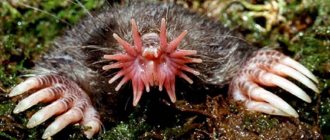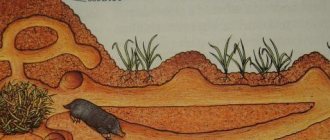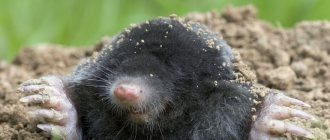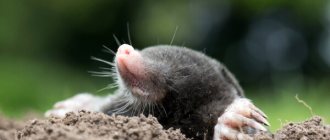Name: Common, South Russian and small-eyed mole rat Lat.:
Spalax microphthalmusClass: Mammals - Mammalia Order: Rodents - Rodentia Family: Mole rats - Spalacidae
| Habitats: | garden |
| Dangerous for: | roots, bulbs and rhizomes |
| Description: | A year-round active animal with a big appetite. |
Description and photo of the animal mole rat
Mole rat.
Mole rats are small animals of the rodent order. Their lifestyle is similar to moles, but outwardly they have significant differences.
Appearance of the animal
Adults can weigh up to 700 grams or more. The animal's body reaches 20-32 cm in length and has an oblong, cylindrical shape. The fur is thick, short, and colored pale gray-brown.
The neck is poorly defined. The legs are very short. The tail is not developed and is hidden under the skin. The head is the widest part of the animal's body and has a flattened shape. The animal has no ears, and its eyes are hidden under the skin. The incisors are pronounced and grow on top of the lips.
Have you seen a mole rat?
Not really
Lifestyle of mole rats
Mole rats on the surface of the earth are a rare occurrence.
The animals spend almost their entire lives underground. The burrow system of this animal is very well branched and has two tiers. The so-called “feeding passage” is the longest and is located at a depth of 20-25 cm. The mole rat’s home is equipped with summer and winter nests, as well as storage facilities for food supplies.
Unlike moles, mole rats make their way with the help of incisors. From the soil that the animal pushes out, characteristic mounds are formed - “mole rats”. The diameter of such “mole rats” can reach 50 cm. The total length of moves made by one rodent can be up to 450 m.
Mole rats do not hibernate in winter and therefore store large reserves of food. Winter supplies of one such rodent can weigh up to 14 kg.
What does the animal eat?
The diet of mole rats consists mainly of plant foods. The animal feeds on bulbs, tubers and rhizomes of various plants. Sometimes a rodent can feast on young stems and leaves, which it drags underground by grasping the rhizome.
Among the animal's winter supplies you can find acorns, onions, potatoes and beets.
Reproduction
An enemy in a fur coat.
Mole rats usually live in groups of 2-3 individuals, including one male and 1-2 females. If there is more than one female in a family, then they take turns producing offspring.
Cubs are born in the spring. Around this time, the male leaves the female who gave birth and goes to the one who will bear offspring next year.
One litter produces 2-3 cubs. Young females begin to move away from their mother already in the first year after birth. They settle mainly closer to the surface, so they often die before reaching two years of age. The mortality rate among young males is much lower, because they move away from their mother only in the second year and settle underground.
The average lifespan of mole rats in the wild is 2.5-4 years. Some specimens can live up to 9 years.
The character and lifestyle of the mole rat
While moles loosen the soil with their front paws, sand mole rats use powerful incisors. The piles of earth after their activity remain larger than those of moles, reaching about 0.5 m.
Pictured is a sand mole rat
The weight of one such pile can reach 10 kg. From 3 to 20 representatives of this species live on 1 hectare of land. The most active period of life of these rodents falls in the spring months. In summer and winter they become less active, but do not hibernate. The labyrinths of passages of giant mole rats are special in their structure.
Their distinctive feature is the tiered tunnel system. So, the top floor of “such a building” is considered food; it is located at a depth of 25 cm. On this tier, rodents collect food: tubers, plant rhizomes. On the second floor there are tunnels, summer and winter nests and storage rooms. It is located deeper - 3-4 m.
In winter, the entrance to these underground galleries is clogged with earth, and the animal lives here until the onset of warmer times. The total area of such labyrinths is 450 m. The number of food pantries in such an area can reach 10 pieces, and winter supplies can be 10 kg. This is such a thrifty animal.
The lifestyle of giant mole rats is solitary. They carefully guard the borders of their territory. Sometimes, collisions between two males end in clashes over territory with fatal results. Their activities cause enormous harm to agriculture.
Signs of a mole rat in the garden are mounds of earth. They not only spoil the aesthetic appearance of the site, but also destroy the crop. The crops most affected by these underground animals are corn, legumes, carrots, beets and potatoes. In just one day, 1 individual can damage 4-6 root crop bushes. A mole rat has taken up residence on your property, how to deal with it ?
You can get rid of this pest by re-digging the soil. This is how I destroy the feeding tiers of their passages. It happens that they are repelled by an unpleasant smell, so you can use special commercial repellers. One of the control options is to catch the mole rat by hand. To do this, a fresh entrance to the hole is determined and another entrance is looked for. Then the section between them is excavated.
Pictured is a giant mole rat
This animal does not tolerate drafts, so it will try to repair the damage. It is at this moment that this pest can be caught. drive a mole rat using water. They find a mound of earth mixed with clay and pour water into the hole nearby.
Mole rat habitat
The habitat of mole rats includes steppe, forest-steppe, semi-deserts and deserts. Most often the animal is found in steppe and flat areas. Since mole rats feed mainly on plant foods, they happily settle in grassy meadows and clearings. In rare cases, mole rats can be found on the outskirts of forests.
When choosing soil, rodents prefer moderate density.
In clay and sandy soils, the mole rat most likely will not stay long.
The animals also do not particularly like salt marshes and wet areas.
Is the mole rat the same mole?
No, this is a wrong opinion. Animals are different, although they have a similar lifestyle.
Do mole rats bite?
Yes, and very much so. But he does not attack himself, but only in case of self-defense. His vision is not developed at all and in case of danger he attacks everyone and everything, relying only on hearing.
How likely is it to meet him?
Although the population is quite large, it is unlikely to encounter a mole rat. If it accidentally hits the surface, it freezes, listening and orienting itself, then backs away to get into its hole.
Features and habitat of the mole rat
The common mole rat is a mammal that belongs to the order of rodents. During evolutionary development, all organs of this animal adapted to the underground lifestyle.
The eyes completely atrophied and lost the ability to see. This is almost the only case in the delight of rodents when a complete loss of vision occurred. The lifestyle of these mammals is exclusively underground. Mole rats , like moles, dig long labyrinths of passages, and they push the excess soil that interferes with them to the surface.
There are 4 species in the mole rat family. Each of them has its own habitat. The animal mole rat chooses steppes, deserts, forest-steppes and forest outskirts for its residence. The soil suitable for their habitat should be of moderate density. Clay and sandy soil is not suitable for them. Their habitat includes forest-steppes and steppes of Moldova, Ukraine and Russia.
A mole rat digs the ground with its teeth
These are mainly pastures or unplowed lands rich in herbaceous vegetation. The mole mole itself is small in size. Its length is 30-32 cm. It weighs from 700 g. up to 1 kg. He leads a rather secluded lifestyle, so few people have seen him live. To correct this oversight and have an idea of the appearance of this animal, we bring to your attention several photos of mole rats .
As you can see in the image, it has no ears, its eyes are hidden under folds of skin, and its small tail is almost invisible. The limbs of this underground inhabitant are short, and the head resembles a bayonet shovel. the mole mole rat digs its tunnels exclusively with its teeth, and not with its paws.
This happens in the following way: the front incisors of the mammal bite into the soil, and then with the help of a shovel-shaped head, crushed lumps of earth are pushed out. The special structure of the jaw and muscles allows the lower incisors to move apart and move them forward and backward.
Such work leads to significant wear on the mole rat's . But don’t worry, the incisors grow very quickly, so this underground inhabitant will not be left without a “tool” for digging his tunnels. By the way, thanks to his work, he not only grinds down the incisors, but also sharpens them when biting into the soil. Animals in captivity deserve more sympathy.
They do not have the opportunity to grind their teeth and sometimes they cannot close their mouth due to the fact that the incisors have grown to enormous sizes. The fur of these giants of their craft is very soft and dark in color. The nose is covered with a keratinized layer of skin. It is this layer that is protective. It protects against various mechanical damage during compaction of the burrow walls.
How to deal with a pest
The mole rat is a rodent whose habits are very similar to the mole. They are often even confused due to similar dietary preferences. The fight against mole rats is carried out using the same methods as with moles. For more information about them, follow the links below to the portal articles.
Plants are a safe way to protect your area from moles and other rodents.
Mole traps allow you to catch the pest quickly and easily.
The greenhouse requires protection from moles; they are comfortable there at any time.
Proven methods of controlling moles on the site. Fast and efficient.
Reproduction and lifespan
Mole rats live alone, but during the breeding season they form family groups. Such a family includes 1 male and 1-2 females. As a rule, members of such families live next door. The male is digging a tunnel to his chosen one. He moves in response to the sounds made by the female.
If there are 2 females in a group, then they take turns breeding. One year the first, the second - another. Such unions disintegrate only in the event of death. 2-3 babies are born per year. This significant event occurs between February and May.
The resettlement of the younger generation is taking place in a unique way. So “girls” are moved to the upper tiers a year after their appearance, and “boys” are moved to the lower floors in the 2nd year. They become sexually mature at 2-3 years of age. The lifespan of mole rats is 2.5 – 9 years.











